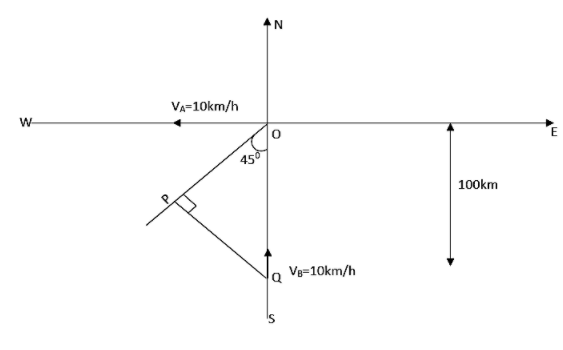
A ship A is moving Westwards with a speed of $10km{{h}^{-1}}$ and a ship B $100km$ South of A is moving northwards with a speed of $10km{{h}^{-1}}$. The time after which the distance between them will become the shortest is given as,
$\begin{align}
& A.5\sqrt{2}h \\
& B.10\sqrt{2}h \\
& C.0h \\
& D.5h \\
\end{align}$
Answer
564.6k+ views
Hint: First of all draw the figure showing the details. Then find the perpendicular distance or the shortest distance between the ships. Now find the resultant of the velocity acting. Therefore the time taken to reach the shortest path will be calculated by dividing the shortest distance travelled by the resultant velocity. These all may help you to solve this question.
Complete answer:
First of all let us draw the diagram.

In the diagram, we can see that the shortest distance between the ship A and ship B will be the perpendicular distance which is represented as PQ in the figure. As the velocities are similar, the angle between them will be $45{}^\circ $. Therefore we can write that,
$\sin 45{}^\circ =\dfrac{PQ}{OQ}$
Where OQ is the distance of the ship B from the axis. This is given in the question as,
$OQ=100km$
Therefore the shortest distance will be obtained by rearranging the equation,
$\begin{align}
& PQ=100\times \sin 45{}^\circ \\
& PQ=100\times \dfrac{1}{\sqrt{2}}=50\sqrt{2}m \\
\end{align}$
Now we can find out the resultant velocity of the ships, which can be written as,
${{V}_{AB}}=\sqrt{{{V}_{A}}^{2}+{{V}_{B}}^{2}}$
Where the velocity of the ship A and ship B are the same. This can be written as,
${{V}_{A}}={{V}_{B}}=10km{{h}^{-1}}$
That is the resultant velocity will be found as,
${{V}_{AB}}=\sqrt{{{V}_{A}}^{2}+{{V}_{B}}^{2}}=\sqrt{{{10}^{2}}+{{10}^{2}}}=10\sqrt{2}km{{h}^{-1}}$
Now let us find out the time of the shortest path. This can be written as the ratio of the shortest distance of travel to the resultant velocity of the ship. Therefore we can write that,
$t=\dfrac{PQ}{{{V}_{AB}}}$
Substituting the values in it,
$t=\dfrac{PQ}{{{V}_{AB}}}=\dfrac{50\sqrt{2}}{10\sqrt{2}}=5h$
Therefore the correct answer is given as option D.
Note: The resultant vector is given as the sum of two or more vectors. Here the resultant velocity is mentioned, which is the sum of two or more velocity vectors. If the two vectors are having the same magnitude as an aligned parallel, then the resultant will be zero.
Complete answer:
First of all let us draw the diagram.

In the diagram, we can see that the shortest distance between the ship A and ship B will be the perpendicular distance which is represented as PQ in the figure. As the velocities are similar, the angle between them will be $45{}^\circ $. Therefore we can write that,
$\sin 45{}^\circ =\dfrac{PQ}{OQ}$
Where OQ is the distance of the ship B from the axis. This is given in the question as,
$OQ=100km$
Therefore the shortest distance will be obtained by rearranging the equation,
$\begin{align}
& PQ=100\times \sin 45{}^\circ \\
& PQ=100\times \dfrac{1}{\sqrt{2}}=50\sqrt{2}m \\
\end{align}$
Now we can find out the resultant velocity of the ships, which can be written as,
${{V}_{AB}}=\sqrt{{{V}_{A}}^{2}+{{V}_{B}}^{2}}$
Where the velocity of the ship A and ship B are the same. This can be written as,
${{V}_{A}}={{V}_{B}}=10km{{h}^{-1}}$
That is the resultant velocity will be found as,
${{V}_{AB}}=\sqrt{{{V}_{A}}^{2}+{{V}_{B}}^{2}}=\sqrt{{{10}^{2}}+{{10}^{2}}}=10\sqrt{2}km{{h}^{-1}}$
Now let us find out the time of the shortest path. This can be written as the ratio of the shortest distance of travel to the resultant velocity of the ship. Therefore we can write that,
$t=\dfrac{PQ}{{{V}_{AB}}}$
Substituting the values in it,
$t=\dfrac{PQ}{{{V}_{AB}}}=\dfrac{50\sqrt{2}}{10\sqrt{2}}=5h$
Therefore the correct answer is given as option D.
Note: The resultant vector is given as the sum of two or more vectors. Here the resultant velocity is mentioned, which is the sum of two or more velocity vectors. If the two vectors are having the same magnitude as an aligned parallel, then the resultant will be zero.
Recently Updated Pages
Master Class 12 Economics: Engaging Questions & Answers for Success

Master Class 12 Maths: Engaging Questions & Answers for Success

Master Class 12 Biology: Engaging Questions & Answers for Success

Master Class 12 Physics: Engaging Questions & Answers for Success

Master Class 8 Maths: Engaging Questions & Answers for Success

Class 8 Question and Answer - Your Ultimate Solutions Guide

Trending doubts
What is meant by exothermic and endothermic reactions class 11 chemistry CBSE

Which animal has three hearts class 11 biology CBSE

10 examples of friction in our daily life

One Metric ton is equal to kg A 10000 B 1000 C 100 class 11 physics CBSE

1 Quintal is equal to a 110 kg b 10 kg c 100kg d 1000 class 11 physics CBSE

Difference Between Prokaryotic Cells and Eukaryotic Cells




